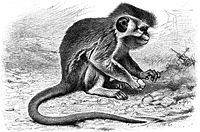Miopithecus
| Talapoins | |
|---|---|
 |
|
| Scientific classification | |
| Kingdom: | Animalia |
| Phylum: | Chordata |
| Class: | Mammalia |
| Order: | Primates |
| Family: | Cercopithecidae |
| Subfamily: | Cercopithecinae |
| Tribe: | Cercopithecini |
| Genus: |
Miopithecus I. Geoffroy, 1842 |
| Type species | |
|
Miopithecus talapoin Schreber |
|
| Species | |
Miopithecus talapoin
Miopithecus ogouensis
Talapoins /ˈtæləpɔɪnz/ are the two species of Old World monkeys classified in genus Miopithecus. They live in central Africa, with their range extending from Cameroon and the Democratic Republic of the Congo to Angola.
With a typical length of 32 to 45 cm and a weight of approximately 1.3 kg (males) and 0.8 kg (females), the talapoins are the smallest Old World monkeys. Their fur is grey green on top and whitish on their underside, much like the vervet monkeys. The head is round and short-snouted with a hairless face.
Talapoins are diurnal and arboreal, preferring rain forest or mangroves near water. They are usually not found in open fields, nor do they seem to be disrupted by humans. Like Allen's swamp monkey, they can swim well and look in the water for food.
These animals live in groups of 60 to 100 animals. They congregate at night in trees close to the water, dividing into smaller subgroups during the day to spread out to find food. Groups are composed of several fully mature males, numerous females and their offspring. Unlike the closely related guenons, they do not have any territorial behaviors. Their vocal repertoire is smaller, as well.
Talapoins are omnivores; their diet consists mainly of fruits, seeds, aquatic plants, insects, shellfish, bird eggs and small vertebrates.
...
Wikipedia
